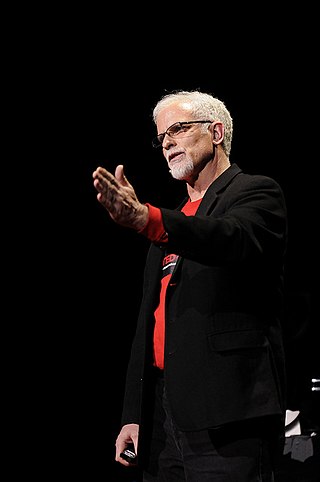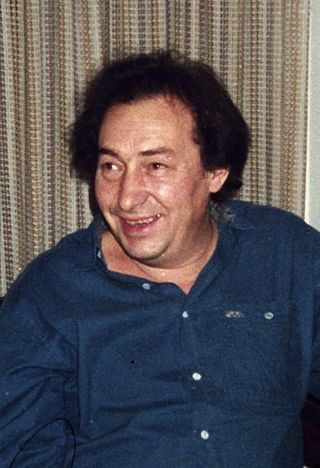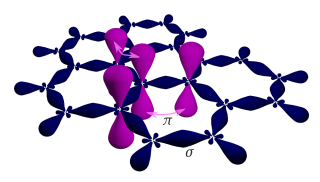
Condensed matter physics is the field of physics that deals with the macroscopic and microscopic physical properties of matter, especially the solid and liquid phases which arise from electromagnetic forces between atoms. More generally, the subject deals with "condensed" phases of matter: systems of many constituents with strong interactions between them. More exotic condensed phases include the superconducting phase exhibited by certain materials at low temperature, the ferromagnetic and antiferromagnetic phases of spins on crystal lattices of atoms, and the Bose–Einstein condensate found in ultracold atomic systems. Condensed matter physicists seek to understand the behavior of these phases by experiments to measure various material properties, and by applying the physical laws of quantum mechanics, electromagnetism, statistical mechanics, and other theories to develop mathematical models.

Yigal Allon was an Israeli military leader and politician. He was a commander of the Palmach and a general in the Israeli Defense Forces (IDF). He was also a leader of the Ahdut HaAvoda and Israeli Labor parties. He served briefly as acting Prime Minister of Israel between the death of Levi Eshkol and the appointment of Golda Meir in 1969, the first native-born Israeli to serve in the position. He was a government minister from the third Knesset to the ninth inclusive.

In physics, dephasing is a mechanism that recovers classical behaviour from a quantum system. It refers to the ways in which coherence caused by perturbation decays over time, and the system returns to the state before perturbation. It is an important effect in molecular and atomic spectroscopy, and in the condensed matter physics of mesoscopic devices.
The conductance quantum, denoted by the symbol G0, is the quantized unit of electrical conductance. It is defined by the elementary charge e and Planck constant h as:

A quantum point contact (QPC) is a narrow constriction between two wide electrically conducting regions, of a width comparable to the electronic wavelength.

Proximity effect or Holm–Meissner effect is a term used in the field of superconductivity to describe phenomena that occur when a superconductor (S) is placed in contact with a "normal" (N) non-superconductor. Typically the critical temperature of the superconductor is suppressed and signs of weak superconductivity are observed in the normal material over mesoscopic distances. The proximity effect is known since the pioneering work by R. Holm and W. Meissner. They have observed zero resistance in SNS pressed contacts, in which two superconducting metals are separated by a thin film of a non-superconducting metal. The discovery of the supercurrent in SNS contacts is sometimes mistakenly attributed to Brian Josephson's 1962 work, yet the effect was known long before his publication and was understood as the proximity effect.
Molecular scale electronics, also called single-molecule electronics, is a branch of nanotechnology that uses single molecules, or nanoscale collections of single molecules, as electronic components. Because single molecules constitute the smallest stable structures imaginable, this miniaturization is the ultimate goal for shrinking electrical circuits.

The atomic nucleus is the small, dense region consisting of protons and neutrons at the center of an atom, discovered in 1911 by Ernest Rutherford based on the 1909 Geiger–Marsden gold foil experiment. After the discovery of the neutron in 1932, models for a nucleus composed of protons and neutrons were quickly developed by Dmitri Ivanenko and Werner Heisenberg. An atom is composed of a positively charged nucleus, with a cloud of negatively charged electrons surrounding it, bound together by electrostatic force. Almost all of the mass of an atom is located in the nucleus, with a very small contribution from the electron cloud. Protons and neutrons are bound together to form a nucleus by the nuclear force.

Michael Lee Roukes is an American experimental physicist, nanoscientist, and the Frank J. Roshek Professor of Physics, Applied Physics, and Bioengineering at the California Institute of Technology (Caltech).

Arkady Girshevich Aronov was a Russian and Israeli theoretical condensed matter physicist, notable for his achievements in physics of semiconductors and in mesoscopic physics.
The Meir-Wingreen formula describes the electric current through an arbitrary mesoscopic system. It was formulated by Yigal Meir and Ned Wingreen. When the interaction between electrons is neglected, this formula reduces to the Landauer formula. This textbook formula has become a standard tool for calculating the current through various systems, such as molecular junctions, quantum dots and nanoscale devices.

Ned S. Wingreen is a theoretical physicist and the Howard A. Prior Professor of the Life Sciences at Princeton University. He is a member of the Department of Molecular Biology and of the Lewis-Sigler Institute for Integrative Genomics, where he is currently director of graduate studies. He is the associate director of the Princeton Center for Theoretical Science, and is also associated faculty in the department of physics. Working with Yigal Meir, Wingreen formulated the Meir-Wingreen Formula which describes the electric current through an arbitrary mesoscopic system.
The proton radius puzzle is an unanswered problem in physics relating to the size of the proton. Historically the proton charge radius was measured by two independent methods, which converged to a value of about 0.877 femtometres. This value was challenged by a 2010 experiment using a third method, which produced a radius about 4% smaller than this, at 0.842 femtometres. New experimental results reported in the autumn of 2019 agree with the smaller measurement, as does a re-analysis of older data published in 2022. While some believe that this difference has been resolved, this opinion is not yet universally held.
Quantum materials is an umbrella term in condensed matter physics that encompasses all materials whose essential properties cannot be described in terms of semiclassical particles and low-level quantum mechanics. These are materials that present strong electronic correlations or some type of electronic order, such as superconducting or magnetic orders, or materials whose electronic properties are linked to non-generic quantum effects – topological insulators, Dirac electron systems such as graphene, as well as systems whose collective properties are governed by genuinely quantum behavior, such as ultra-cold atoms, cold excitons, polaritons, and so forth. On the microscopic level, four fundamental degrees of freedom – that of charge, spin, orbit and lattice – become intertwined, resulting in complex electronic states; the concept of emergence is a common thread in the study of quantum materials.

Graphene is a semimetal whose conduction and valence bands meet at the Dirac points, which are six locations in momentum space, the vertices of its hexagonal Brillouin zone, divided into two non-equivalent sets of three points. The two sets are labeled K and K'. The sets give graphene a valley degeneracy of gv = 2. By contrast, for traditional semiconductors the primary point of interest is generally Γ, where momentum is zero. Four electronic properties separate it from other condensed matter systems.
Suchitra Sebastian is a condensed matter physicist at Cavendish Laboratory, University of Cambridge. She is known for her discoveries of exotic quantum phenomena that emerge in complex materials. In particular, she is known for the discovery of unconventional insulating materials which display simultaneous conduction-like behaviour. In 2022 she was awarded the New Horizons in Physics Prize by the Breakthrough Foundation. She was named as one of thirty Exceptional Young Scientists by the World Economic Forum in 2013, one of The Next Big Names in Physics by the Financial Times in 2013, and spoke at the World Economic Forum at Davos in 2016.

Ron Folman (Hebrew: רון פולמן;, is an Israeli quantum physicist and social activist. He works at the Ben-Gurion University of the Negev where he heads the Atom Chip group.

Amnon Aharony is an Israeli Professor (Emeritus) of Physics in the School of Physics and Astronomy at Tel Aviv University, Israel and in the Physics Department of Ben Gurion University of the Negev, Israel. After years of research on statistical physics, his current research focuses on condensed matter theory, especially in mesoscopic physics and spintronics. He is a member of the Israel Academy of Sciences and Humanities, a Foreign Honorary Member of the American Academy of Arts and Sciences and of several other academies. He also received several prizes, including the Rothschild Prize in Physical Sciences, and the Gunnar Randers Research Prize, awarded every other year by the King of Norway.
Leslie Leiserowitz is an Israeli chemist and crystallographer.

Mordehai "Moty" Heiblum is an Israeli electrical engineer and condensed matter physicist, known for his research in mesoscopic physics.













